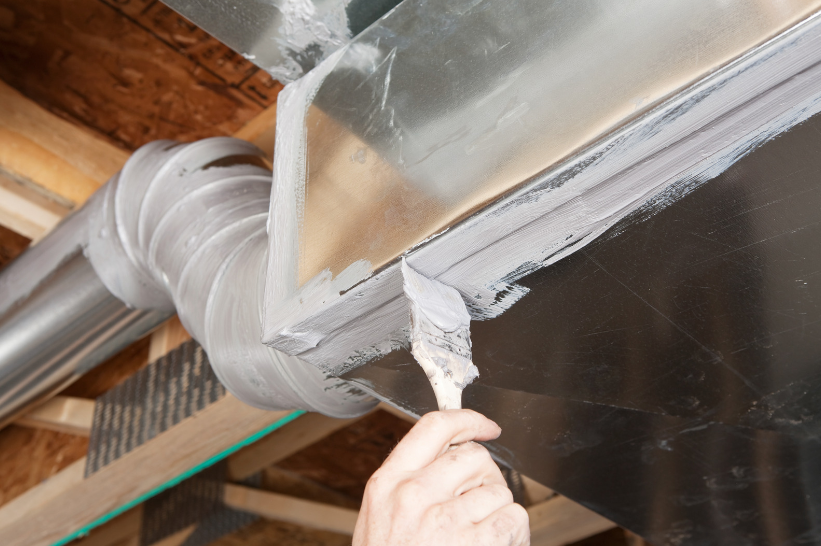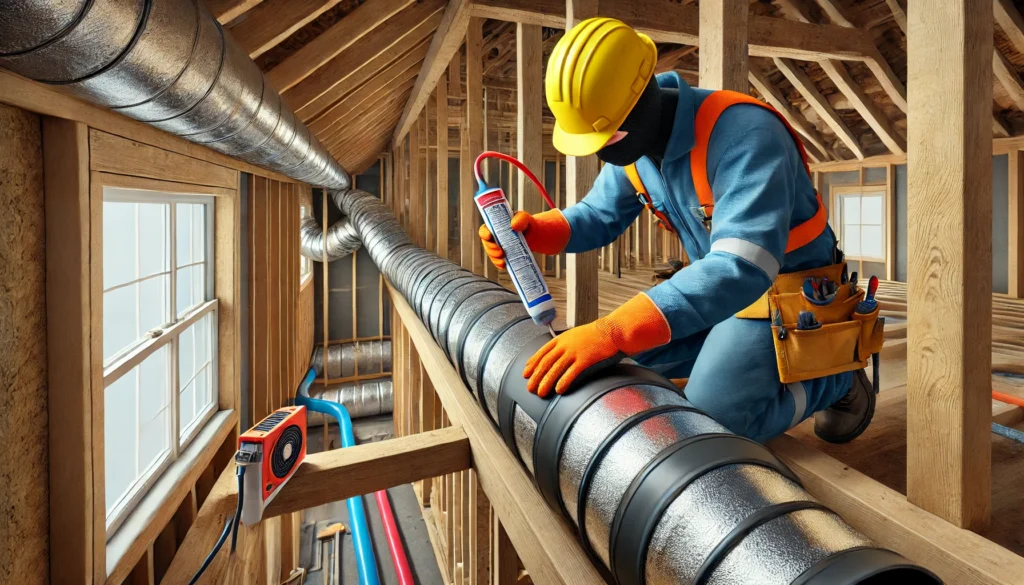Answered: Top 5 Air Duct Sealing Methods

Leaky air ducts may be a hidden cause of your rising energy bills. Studies show that up to 30% of heated or cooled air can escape through gaps in ductwork. This energy loss forces your HVAC system to work harder, increasing utility costs and inconsistent indoor comfort. Addressing duct leakage can significantly impact your home’s efficiency and air quality.
Sealing your air ducts reduces wasted energy and helps create a more comfortable living environment by ensuring even heating and cooling throughout the house. From simple DIY solutions like mastic sealant and foil tape to professional options such as Aeroseal, each method offers unique benefits based on your home’s needs.
These five proven duct sealing methods provide homeowners with options that reduce costs, improve HVAC performance, and boost indoor air quality, whether you’re tackling the project yourself or hiring a professional.
Key Takeaways
- Duct sealing can reduce energy waste by up to 30%.
- Mastic sealant and foil tape are effective and easy DIY methods for small leaks.
- Aeroseal technology can seal up to 90% of duct leaks, especially in hard-to-reach places.
- Duct insulation works best when paired with sealing, especially in unconditioned spaces like attics.
- Choosing the proper sealing method depends on the location of your ducts, the size of the leaks, and your budget.

Top 5 Duct Sealing Methods
Here’s a closer look at five techniques for keeping your ducts sealed, energy efficient, and home comfortable.
1. Mastic Sealant
Mastic sealant is a versatile, flexible substance used to seal gaps in ductwork. It’s durable and resistant to temperature changes, making it a long-lasting solution for duct leaks. It adheres well to various duct materials, such as metal and fiberglass.
How to Apply: You can use a brush or caulk gun to apply mastic directly to the leaky areas. Combine mastic with mesh tape for more significant gaps to ensure a tight seal.
Best for: Small to medium-sized leaks, especially in easy access areas.
Advantages:
- Forms a tough, durable seal.
- Works well with various duct materials.
- Helps reduce energy bills and improves HVAC efficiency.
Pro Tip: Always clean the ducts thoroughly before applying mastic to ensure the best adhesion and performance.
2. Foil Tape
Foil tape is a quick and effective fix for sealing duct seams and joints. It’s made of a thin layer of metal foil with an adhesive backing that can withstand high temperatures, making it ideal for HVAC systems.
How to Apply: First, clean the duct surface. Then, cut the foil tape to size and press it firmly over the seams or joints, smoothing out any wrinkles or bubbles for an airtight seal.
Best for: Small leaks and seams, especially in areas that get very hot or cold.
Advantages:
- Quick and easy to apply.
- Works well for high-temperature areas.
- Offers long-term durability.
Pro Tip: Smoot out bubbles in the tape to prevent future air leaks.
3. Duct Sealant Spray
Duct sealant spray is a convenient aerosol product that forms a flexible seal over small gaps and cracks in ductwork. It’s especially useful in hard-to-reach areas where applying mastic or tape would be difficult.
How to Apply: Simply spray the sealant directly onto the leaks. The sealant expands to fill small gaps and cracks, drying quickly to form a lasting seal.
Best for: Tight spots and small leaks (up to 1/8 inch wide).
Advantages:
- Quick and easy application.
- Reaches areas that other methods can’t.
- Works on a variety of duct materials.
Limitations: You’ll need to use mastic or other methods to ensure a proper seal for larger gaps.
4. Aeroseal Technology
Aeroseal takes duct sealing to the next level. This advanced method uses tiny particles blown into the duct system, which attach to the edges of leaks and gradually close them. It can seal up to 90% of duct leaks, even in inaccessible areas.
How It Works: A machine pumps a sealing aerosol into your duct system. The particles are drawn to leaks, where they bond to the edges of gaps and cracks, creating a durable seal over time.
Best for: Hard-to-reach ducts, including those hidden behind walls or in tight spaces.
Advantages:
- Seals up to 90% of duct leaks.
- Reaches areas that are difficult to access manually.
- Great for improving overall airflow and HVAC performance.
Consideration: Aeroseal duct sealing costs more than other methods, but its effectiveness and long-lasting results are often worth the investment.
5. Duct Insulation
After sealing your ducts, consider adding insulation, especially in unconditioned spaces like attics or basements. Insulating your ducts helps maintain the air temperature as it travels through your system, reducing energy waste.
How to Apply: Wrap your sealed ducts in insulation with an R-value between 6 and 8 for best results. This is especially important in areas where temperature differences between inside and outside the ducts are significant.
Best for: Unconditioned spaces like attics, crawlspaces, and basements.
Advantages:
- Reduces energy waste by preventing temperature loss.
- Helps prevent moisture build-up, which can lead to mold or mildew.
Pro Tip: Pair duct insulation with a reliable sealing method like mastic or Aeroseal for maximum energy savings.
Cost Comparisons by Duct Sealing Method
Here’s a quick breakdown of the costs involved for each duct sealing method:
| Method | Cost (DIY/Material) | Cost (Professional Installation) | Best For |
|---|---|---|---|
| Mastic Sealant | $10–$25 per gallon (DIY) | $300–$500 for full system | Small to medium leaks, accessible areas |
| Foil Tape | $5–$15 per roll (DIY) | $100–$300 for full system | Small leaks, joints, and seams |
| Duct Sealant Spray | $20–$50 per can (DIY) | $200–$400 for full system | Tight spots, small leaks up to 1/8 inch |
| Aeroseal | N/A (requires professional) | $1,000–$3,200 for full system | Hard-to-reach leaks, large systems |
| Duct Insulation | $1–$3 per square foot (DIY) | $500–$2,000 depending on size | Unconditioned spaces like attics or basements |
How to Choose the Right Duct Sealing Method
The best sealing method for your home depends on several factors. Here’s how to make the right choice:
Location of Ducts:
- Ducts in attics or crawl spaces may need extra insulation after sealing.
Size of Leaks:
- For small leaks, foil tape or spray sealants work well. More significant gaps require mastic or Aeroseal.
DIY Skills:
- Homeowners can easily apply mastic or foil tape. Aeroseal requires professional installation.
Budget:
- Foil tape and mastic are cost-effective for smaller jobs. Aeroseal is a more significant investment but offers the most comprehensive sealing.
Climate Considerations:
- In hot, humid areas, opt for methods addressing moisture issues, such as Aeroseal and duct insulation.
Conclusion
Properly sealed ducts can dramatically improve home comfort and reduce energy bills by up to 30%. Whether you apply mastic sealant yourself or hire a professional to use Aeroseal, the proper method depends on your situation. Don’t overlook the benefits of air duct sealing or adding insulation, especially in unconditioned spaces, to enhance your system’s efficiency.
DIY methods like mastic and foil tape are excellent choices for minor fixes. For larger, more complex leaks, consider consulting a professional offering long-term solutions with Aeroseal. Investing in duct sealing today means cleaner air, a more efficient HVAC system, and lower energy costs for years.


